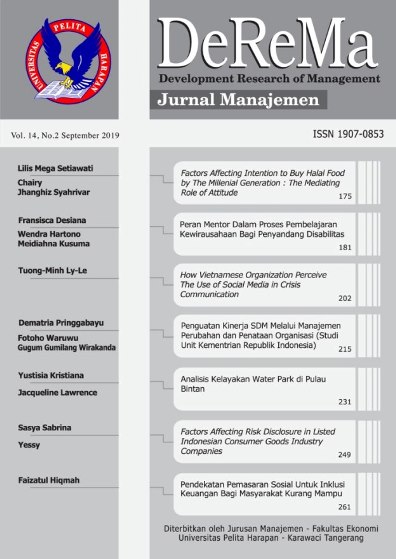How Vietnamese Organizations Perceive the Use of Social Media in Crisis Communication
DOI:
https://doi.org/10.19166/derema.v14i2.1552Schlagworte:
social media, social media adoption, crisis communication, crisis response, VietnamAbstract
Social media has proliferated into the everyday life of Vietnamese people. As a result, in the past years, Vietnam has seen many organizational crises that started on this platform. Social media has proven to be able to foster crises, thanks to open platforms that allow for relatively free discussion among strangers with common interests. Nonetheless, Vietnamese organizations have often ignored or underutilized these channels in their crisis communication efforts. Organizations prioritize using traditional media in their crisis communication efforts and paid little to no attention to social media outlets, even if the crisis had started on social media channels. Through a survey with experienced Vietnamese PR practitioners, this research aims to understand this trend of crisis management and explore the perception of Vietnamese organizations toward the use of social media in crisis communication.
Bahasa Indonesia Abstrak: Media sosial telah menjamur ke dalam kehidupan sehari-hari rakyat di Vietnam. Akibatnya, dalam beberapa tahun terakhir, Vietnam telah melihat banyak krisis organisasi yang dimulai pada platform ini. Media sosial telah terbukti mampu menumbuhkan krisis, berkat platform terbuka yang memungkinkan diskusi bebas untuk kepentingan bersama. Meskipun demikian, organisasi di Vietnam sering mengabaikan atau kurang memanfaatkan saluran-saluran ini dalam upaya krisis komunikasi yang mereka alami. Organisasi lebih memprioritaskan menggunakan media tradisional dalam upaya menanggulangi krisis komunikasi mereka dan sedikit memberikan perhatian kepada outlet media sosial, bahkan jika krisis telah dimulai pada saluran media sosial. Melalui survei yang dilakukan oleh praktisi PR di Vietnam yang berpengalaman, penelitian ini bertujuan untuk memahami tren manajemen krisis ini dan mengeksplorasi persepsi organisasi di Vietnam terhadap penggunaan media sosial dalam komunikasi krisis.
Literaturhinweise
Austin, L., Liu, B. F., & Jin, Y. (2012). How audiences seek out crisis information: Exploring the social- ediated crisis communication model. Journal of Applied Communication Research, 40(2), 188-207. https://doi.org/10.1080/00909882.2012.654498
Bao Dien Tu DCSVN. (2012, June 7). Media and social media. Ha Noi Moi. Retrieved from http://hanoimoi.com.vn/Tin-tuc/Chinh-tri/549777/bao-chi-va-su-dung-mang-xa-hoi
Coombs, W. T. (2014). Ongoing crisis communication: Planning, managing and responding (4th ed.). Thousand Oaks, CA: Sage.
Jaques, T. (2014). Issue and crisis management: Exploring issues, crises, risk and reputation. Victoria, Australia: Oxford.
Kemp, S. (2017, February 16). Digital in Southeast Asia in 2017. Retrieved from https://wearesocial.com/uk/special-reports/digital-southeast-asia-2017
Kerkhof, P., Beugels, D., Utz, S., & Beukeboom, C. (2011, May). Crisis PR in social media: An experimental study of the effects of organizational crisis responses on Facebook. Paper presented at The 61st annual ICA conference, Boston.
Ly-Le, T. M. (2018). Social media use in crisis communication in Vietnam: A stakeholder’s viewpoint. Proceedings of the Fifth International Conference on Business, Management and Accounting (IBSM 2018), 259-274.
McLean, H., & Power, M. (2009). Crisis command: Strategies for managing corporate crises. London: Ark Group.
Procopio, C. H., & Procopio, S. T. (2007). Do you know what it means to miss New Orleans?: Internet communication, geographic community, and social capital in crisis. Journal of Applied Communication Research, 35(1), 67-87. https://doi.org/10.1080/00909880601065722
Richter, F. (2014, March 28). 30% of U.S. adults get news on Facebook. Retrieved from http://www.statista.com/chart/2069/news-consumption-on-social-networks/
Ruehl, C. H., & Ingenhoff, D. (2015). Communication management on social networking sites: Stakeholder motives and usage types of corporate Facebook, Twitter and YouTube pages. Journal of Communication Management, 19(3), 288-302. https://doi.org/10.1108/JCOM-04-2015-0025
Schultz, F., Utz, S., & Glocka, S. (2012). Towards a networked crisis communication theory: Analyzing the effects of (social) media, media credibility, crisis type, and emotions. In Proceedings of the International Communication Association. Phoenix: All Academics.
Sweetser, K. D., & Metzgar, E. (2007). Communicating during crisis: Use of blogs as a relationship management tool. Public Relations Review, 33(3), 340-342. https://doi.org/10.1016/j.pubrev.2007.05.016
Ulmer, R., Sellnow, T., & Seeger, M. (2015). Effective crisis communication: Moving from crisis to opportunity (3rd ed.). London: Sage.
Van, L. T. H. (2013). Contemporary public relations in Vietnam: Public relations challenges in a culturally different setting (PhD thesis).
Downloads
Zusätzliche Dateien
Veröffentlicht
Ausgabe
Rubrik
Lizenz
Authors who publish with this journal agree to the following terms:
1) Authors retain copyright and grant the journal right of first publication with the work simultaneously licensed under a Creative Commons Attribution License (CC-BY-SA 4.0) that allows others to share the work with an acknowledgement of the work's authorship and initial publication in this journal.
2) Authors are able to enter into separate, additional contractual arrangements for the non-exclusive distribution of the journal's published version of the work (e.g., post it to an institutional repository or publish it in a book), with an acknowledgement of its initial publication in this journal.
3) Authors are permitted and encouraged to post their work online (e.g., in institutional repositories or on their website). The final published PDF should be used and bibliographic details that credit the publication in this journal should be included.





